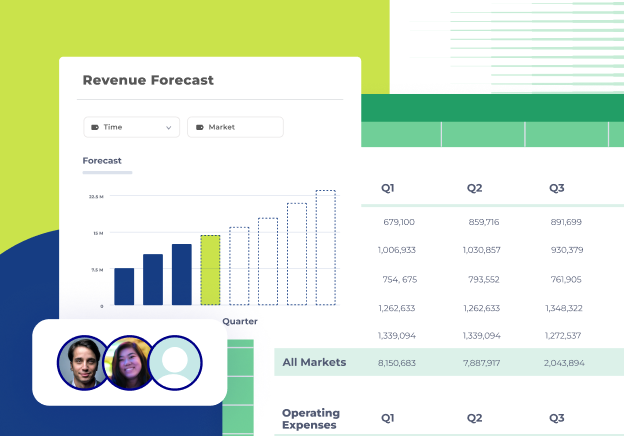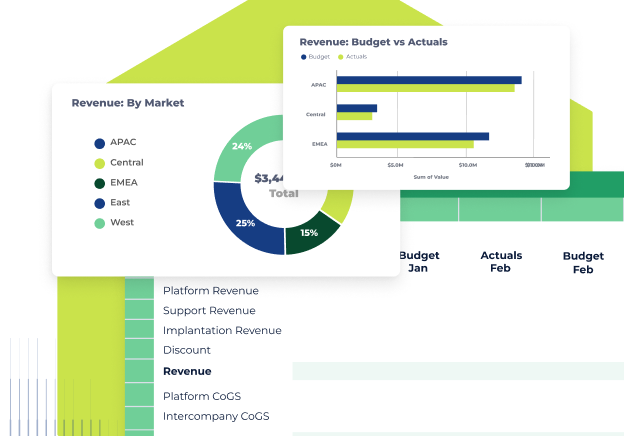The role of AI in modern FP&A
AI is transforming FP&A by tackling some of the biggest challenges finance teams face: manual processes, inconsistent data, and the need for more accurate predictions. AI automates repetitive tasks like data collection, consolidation, and basic reporting, allowing teams to focus on higher-value activities like strategy and decision-making. This saves time, reduces errors, and leads to more reliable outputs.
AI’s ability to identify trends in large datasets is another game-changer. Traditional methods often miss subtle patterns, but AI uses advanced algorithms to analyze historical and real-time data, uncovering insights that might otherwise go unnoticed. For FP&A leaders, this means better forecasting, more informed scenario planning, and the ability to adapt quickly to changes in the market or business conditions.
Put simply, AI ensures FP&A is not just keeping up, but staying ahead.
Benefits of AI in FP&A
- Automation: AI reduces the time spent on manual processes like data collection, consolidation, and report generation. This allows teams to focus on more strategic tasks, improving productivity and efficiency.
- Enhanced forecasting accuracy: AI uses advanced algorithms to analyze historical data, identify patterns, and generate more accurate forecasts. This helps FP&A teams anticipate market trends, budget needs, and potential risks with greater confidence.
- Real-time insights: AI processes data in real time, giving teams up-to-date insights. This enables faster decision-making and a proactive approach to addressing changes in the business environment.
- Better scenario planning: With AI, FP&A teams can quickly model multiple “what-if” scenarios to evaluate the potential outcomes of different strategies. This supports smarter, data-driven decision-making in uncertain or dynamic conditions.
- Deeper data analysis: AI can handle large, complex datasets, uncovering trends and relationships that might not be visible with traditional analysis. This leads to more comprehensive insights and a better understanding of business performance.
- Improved collaboration: AI-powered tools often include features like real-time dashboards and shared analytics, making it easier for FP&A teams to collaborate with other departments. This aligns financial goals with broader business objectives.
- Cost savings: By automating time-intensive processes and reducing errors, AI helps organizations save both time and money. It also optimizes resource allocation by highlighting areas where spending can be reduced or redirected.
- Proactive risk management: AI can identify potential risks by analyzing both internal and external data. This allows organizations to mitigate risks before they escalate, ensuring more stable financial planning.
- Customization and scalability: Many AI tools are highly customizable, allowing businesses to tailor them to specific needs. They are also scalable, making them suitable for organizations of any size as they grow.
- Strategic focus: AI frees up FP&A teams to focus on strategy by handling routine tasks and providing actionable insights. This helps FP&A teams contribute more meaningfully to long-term business growth.

Key features to look for in AI tools for FP&A
Not all AI tools are created equal, and choosing the right one can make all the difference for your team. The most effective tools share a few critical features that help FP&A leaders maximize their value.
1. Seamless integration
An ideal AI tool works with your existing financial systems and related databases, like ERPs, CRMs, or BI platforms, without requiring a complete overhaul. Integration ensures smooth workflows, reduces disruptions, and helps consolidate data from multiple sources into one central view.
2. Real-time analytics
The ability to analyze and update data in real time is essential for adapting to changing market and business conditions. Real-time insights empower teams to make timely decisions, respond quickly to new information, and stay ahead of market shifts.
3. Advanced forecasting
AI excels at predictive modeling, uncovering patterns in historical data to forecast future trends with greater accuracy. This can help FP&A teams anticipate risks, identify opportunities, and test multiple “what-if” scenarios to improve strategic planning.
4. Customization
Every business is unique, and AI tools should reflect that. Look for solutions that let you tailor dashboards, reports, and workflows to your specific needs, ensuring the tool works for your team—not the other way around.
5. User-friendly design
Even the most powerful AI tools won’t deliver results if teams can’t use them effectively. A clean, intuitive interface and easy-to-learn functionality are key to adoption, ensuring the tool becomes a valuable part of your financial processes, not a burden.
Top AI tools for FP&A leaders in 2025
With so many AI tools available, it’s important to focus on solutions that address the specific needs of FP&A teams. Here’s a look at some of the top tools shaping the future of financial planning and analysis in 2025:
1. Cube
.png?width=252&height=73&name=blue-cube-logo%20(1).png)
Cube is a FP&A software tool that streamlines financial planning, reporting, and analysis processes for businesses. With Cube's FP&AI Suite, finance teams never have to start from a blank spreadsheet again. Cube takes the first pass at plans and reports, so you’re free to focus on the strategy that drives the business forward.
The platform allows users to connect their existing enterprise resource planning (ERP), human resource information system (HRIS), and customer relationship management (CRM) systems directly to Excel and Google Sheets, providing a single source of truth for all financial data.
Cube tops the list due to its flexible and frictionless integration with existing spreadsheets, user-friendly report generation, and finance-first design. It’s even been recognized for its ease of administration, excellent customer support, and high user adoption rates by customers.
Part of Cube's FP&AI Suite is the AI Analyst which, unlike other agentic agents, was purpose-built for FP&A. As the AI Agent questions—about your own data—that you'd ask any analyst on your team, and receive instant answers with contextual summaries and interactive reports. Cube's AI Analyst works across Slack, Teams, and the Cube Workspace adding speed and clarity at your fingertips.
.png?width=521&height=473&name=Understand-variances-image%20(2).png)
Key AI features:
- Smart forecasting: With AI Smart Forecasting, jumpstart planning tasks by creating an AI-proposed forecast that you can use as a starting point or benchmark for your existing plans.
- Proactive variance analysis: Cube's AI offers you the first analysis of your variances so you can decide where to dig in deeper to help get the company back on track.
- Automated data validation: By automatically identifying inconsistencies and highlighting potential errors, Cube helps you maintain clean, reliable data so you can drive decisions with confidence.
Pricing: Custom pricing starts at $30,000 annually. Get a custom quote today.
2. Anaplan

Anaplan is a business planning, forecasting, and performance management software platform that lets businesses connect their financial, strategic, and operational planning in real time. Recently, Anaplan has ventured into artificial intelligence and machine learning, providing practical insight into a company’s data.

Key AI features:
- PlanIQ: PlanIQ combines Anaplan’s Connected Planning platform with machine learning (ML) capabilities and deep learning algorithms to generate accurate future forecasts. It leverages Amazon’s forecast engine and Anaplan's native algorithms, such as multivariate linear regression (MVLR) and Anaplan Prophet, to help customers make more informed predictions.
- Predictive insights: Finance teams can use predictive insights to create sales plans based on customer insights and buyer-intent data. Finance teams can use it to understand their most profitable segments and target accounts.
- Optimizer: Optimizer provides predictive analytics capabilities and linear optimization algorithms.
Pricing: Anaplan pricing is not publicly available.

3. Vena

Vena Insights is an FP&A platform that integrates with Microsoft Excel and Power BI. It’s designed to assist with financial and operational planning processes for businesses. Vena Insights provides real-time data for AI-powered reporting and financial analysis, enabling finance teams to make informed decisions.

Key AI features:
- Predictive analytics: Leverage AI to analyze historical and current data, providing insights that help you anticipate future trends and outcomes with greater accuracy.
- Predictive forecasting: Improve forecast accuracy by using advanced AI models that incorporate real-time data and adapt to changing conditions, enabling more strategic planning.
- Anomaly detection: Automatically identify outliers and unusual patterns in your data to help you address risks, inefficiencies, or potential opportunities before they escalate.
- Data Analysis Expressions (DAX): Utilize DAX formulas to create sophisticated calculations and models that add depth and precision to your analysis, making your reporting more insightful.
Pricing: Vena pricing is not publicly available.
4. Planful

Planful Predict is a suite of AI-powered tools designed to assist FP&A by providing intelligent insights and automation capabilities. It leverages machine learning to improve the efficiency of budgeting, forecasting, and financial reporting processes. Planful Predict can check for errors and identify patterns to assist in financial decision-making.
Predict: Signals is the first tool in the Planful Predict suite, designed to leverage AI to identify emerging trends and opportunities by analyzing data signals in real time. This has since been followed by Predict: Projections, an advanced AI tool that enhances forecasting capabilities.

Features:
- Risk identification: Identifies and flags risks, errors, and outliers in data
- Predictive analytics: Analyzes historical data to generate predictive forecasts for planning and budgeting
- Error detection: Continuously reviews data for potential errors before reports are published
- Dynamic Commentary: Facilitates real-time collaboration through features like Dynamic Commentary
Pricing: Pricing is not publicly available.
5. Datarails

Datarails is an FP&A platform designed specifically for Excel users. It enables finance teams to automate data consolidation, reporting, and planning. In March 2023, Datarails announced their venture into the world of AI with FP&A Genius, a set of AI tools that transforms the way finance teams work.

Key AI features:
- Conversational interface: FP&A Genius allows CFOs to ask direct questions and receive instant, accurate answers without needing to manually manipulate data.
- Robust security: Data handled by FP&A Genius is protected, and any external data integrated into the platform comes exclusively from verified and trusted sources.
- Formatted, actionable reporting: Reports are generated instantly and can be customized to fit any reporting need, including monthly, quarterly, or ad hoc formats. These reports are delivered in formats like PDFs and enriched with AI-driven insights, such as variance explanations and recommendations for corrective actions.
Pricing: Datarails pricing is not publicly available.

Tips for implementing AI in FP&A
Adopting AI tools can transform FP&A processes, but successful implementation requires careful planning and execution. Here are some practical tips to help you get the most out of your investment:
1. Start small with high-impact use cases
Begin with a specific, high-impact task, such as automating data consolidation or enhancing forecasting accuracy. Piloting AI in focused areas allows teams to build confidence, measure results, and fine-tune the tool before scaling across the organization.
2. Ensure data readiness
AI tools are only as good as the data they analyze. Before implementation, clean and organize your data to eliminate inconsistencies or gaps. Invest in robust data governance practices to ensure that data remains accurate and reliable over time.
3. Train your team
Adoption is key to success. Provide thorough training to help your team understand how to use AI tools effectively. Focus on both technical skills and the strategic applications of AI, so users see how it aligns with their goals and workflows.
4. Monitor and measure ROI
Track the performance of your AI tools by measuring key metrics such as time saved, forecasting accuracy, and decision-making speed. Regular reviews will help you identify areas for improvement and demonstrate the value of AI to stakeholders.
5. Promote cross-functional collaboration
AI’s real power comes when it connects finance with other departments. Use AI-generated insights to align teams around shared goals and improve communication. For example, share real-time dashboards with sales and operations to drive better organizational decision-making.
Conclusion
AI is no longer a "nice-to-have" for FP&A leaders—it’s necessary to stay competitive. From automating repetitive tasks to delivering predictive insights, the right AI tools can transform how finance teams operate.
The journey to adopting AI may seem complex, but the benefits far outweigh the challenges. Whether you're looking to enhance forecasting, streamline workflows, or improve collaboration, now is the time to invest in the tools that will shape the future of FP&A.
Request a free demo today to see how Cube's FP&AI Suite can empower your finance team to make better, data-driven decisions faster.



.png)









.png)

.png)

.png?width=252&height=73&name=blue-cube-logo%20(1).png)
.png?width=521&height=473&name=Understand-variances-image%20(2).png)





.png)
.png)
.png)